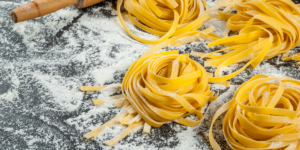Pasta is a staple of Italian cuisine, and with over 300 different variations, there’s a type of pasta to suit every taste and dish. Each type of pasta has its own unique characteristics and pairing possibilities. Whether you’re a pasta aficionado or just starting to explore the world of Italian cuisine, this guide will inspire your next delicious pasta dish.
Linguine
Linguine pasta stands between spaghetti and fettuccine, being slightly wider than spaghetti but not as wide as fettuccine. It is usually mistaken for fettuccine because it is also flat.
This pasta is traditionally served with pesto, fish, or tomato sauce. It makes the most delicious seafood dish because its flat surface allows it to cling to sauces.

Rigatoni
This is a short, tube-shaped, somewhat thick pasta with ridges.
Rigatoni is the go-to pasta for baked pasta recipes. It also works well with salads. Its ridges and tube-like shape make it perfect for holding sauces, pastes, and salad dressing.

Gnocchi
You can call this one a pasta dumpling. Gnocchi (pronounced “nyoki”) is a pasta shaped like dough balls. Unlike most pastas which are made from wheat or durum, this one is typically made from potato.
It is light and soft and is best paired with bold flavors. Whether it is a side dish or a main course, you can enjoy it with melted butter and pesto or a light creamy sauce.

Fusilli
If you find it hard to identify fusilli, think of a corkscrew. The pieces of this pasta have a striking resemblance to the spiral part of a corkscrew. Fusilli is not to be confused with rotini, which has tighter and shorter spirals.
A sauce that would swallow up your spaghetti would make a perfect base for fusilli. The crevices between the spirals of this pasta make it easy to infuse heavy sauces into it. It also goes well with vegetable salads.

Penne
Penne pasta is a narrower version of rigatoni with diagonally cut ends. Because of the shape of its tip, its name is suspected to come from the quill pen.
The love for this pasta is most likely owing to its versatile nature. Whether served cold in a salad or piping hot in an oven-baked pasta dish, penne will always leave you wanting more.

Spaghetti
Finally, a name you recognize, lol. Spaghetti is probably the most popularly known pasta. Contrary to popular belief, pasta is not another name for spaghetti. Spaghetti is a type of pasta.
This food is thin enough to serve with a light cream base. Still, it works well with heavier sauces like tomato sauce, like in spaghetti bolognese. But spaghetti is a crowd-pleaser even with a little olive oil and garlic.

Fettuccine
After spaghetti and Macaroni, fettuccine pasta may be the most known pasta. Just like linguine, it is flat but is much wider.
Fettuccine with a creamy, cheesy base is a match made in heaven. As the creamy sauce coats the pasta strands, its bold and rich flavor complements the milder, delicate flavor of the pasta.

Bucatini
Thick creams and sauces often overshadow spaghetti. Bucatini, in contrast, is perfect for thick creams and sauces. At a glance, it looks just like spaghetti, but on closer inspection, you would realize it is thicker than spaghetti and has a hollow center.
The best sauce to serve bucatini with is amatriciana sauce. This classic Italian pasta sauce is made with guanciale, tomatoes, garlic, and Pecorino Romano cheese.

Orzo
Orzo pasta looks like long-grain rice. Adding to soup gives it a hearty flavor and contrasting texture. Toasting orzo gives it a nutty taste, which can bring the A-game to your salad recipe.
But be careful when cooking with this pasta. It has a reputation for becoming al dente after only five minutes of cooking. Cooking it any further will make it mushy. We recommend adding it to your meal only when it is almost finished cooking.

Macaroni
Macaroni is an elbow-shaped, tube-like pasta. It is an awesome substitute for spaghetti, especially in recipes like spaghetti bolognese.
Like fettuccine, macaroni and cheese go hand in hand. The all-famous mac-and-cheese recipe promises a tasty adventure with every new bite. Other macaroni recipes include goulash and nacho beef casserole.

Farfalle
Children especially find this pasta fun to cook with because of its bowtie or butterfly shape. More than an artistic delight, it is exceptionally tasty.
Because of its delicate texture, it is not easily overpowered by light cream sauces, and in a vegetable mix, it gives a complementary texture.
Like other short, small pasta, cooking it up until al dente is the ideal way of preparation.

Conchiglie
Shell pasta, otherwise known as conchiglie, is one of the tastiest pasta dishes. The name originates from its shell-like shape.
Its structure makes it easy to stuff ingredients like bits of cheese or vegetables and in larger-sized shells, meat! The jumbo-sized variations are often used in baked pasta recipes.
Conchiglie is easily mistaken for cavatelli. Both differ in size, with cavatelli being smaller and slightly longer.

Capellini
Capellini, better known as angel hair pasta, is very thin and long—it is even thinner than spaghettini!
This pasta is perfect for anything stir fry. It does not work well with recipes that require long periods of cooking or large volumes of water.
When it comes to sauce pairing and capellini, opt for lighter sauces that won’t overshadow the pasta. Your best bet is seafood sauce, light tomato sauce, or olive oil and vinegar.

Vermicelli
It is impossible to give a fixed answer regarding the size of vermicelli. In the U.S. and other English-speaking countries, it is thinner than spaghetti, whereas vermicelli in Italy is thicker than spaghetti.
Vermicelli is also called spaghettini. This means it makes a great substitute for both spaghetti and capellini. Cook this pasta with a little water and a rich sauce to bring out the most of it.
Next time you have guests over, wow them with a nicely made spaghettini carbonara dish.

The takeaway
Many other pasta types include lasagna, ravioli, tortellini, Campanella, and radiator. With this comprehensive list of pasta types, you can explore the vast and delicious world of Italian cuisine. From the classic spaghetti and fettuccine to the more unique rigatoni and gnocchi, each type of pasta offers a new and exciting culinary experience. Remember to consider each pasta’s shape, size, and texture when pairing it with sauces and ingredients, and don’t be afraid to experiment and try new combinations. Buon appetito!










